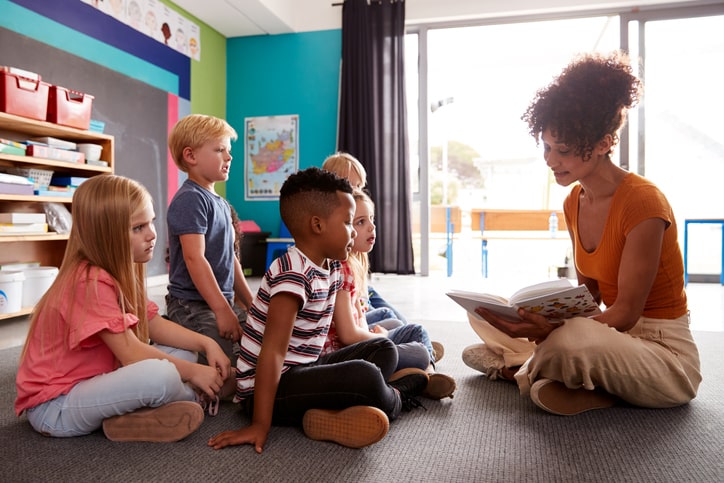Creating a positive classroom environment: 5 golden rules for the classroom that promote respect, responsibility, engagement, safety, and learning success.
5 Golden Rules for the Classroom
All students need an identified set of classroom rules to follow, that’s why the 5 golden rules for the classroom are essential for all students. These rules are not only vital for classroom management, but they also establish the learning environment's atmosphere.
Regardless of whether you're teaching elementary, middle, or high school students, displaying these 5 golden rules can prevent disruptions that could hinder learning.
Classroom rules vs. classroom procedures
The best classroom rules apply to every student entering your learning environment. It doesn’t matter if one class is studying history and another is learning Spanish. The rules should be the same for all.
Classroom procedures, however, may differ for each class period. For example, a science class might have a certain procedure to follow for using worksheets during a lab experiment. In classrooms where small group activities are commonplace, like language arts or history classes, there will need to be transition procedures that involve moving desks and gathering materials.
Throughout the school day, you might have students who are allowed to use electronic devices for learning games or viewing helpful videos. In some class periods, cell phones may be completely off-limits. You should have procedures in place for using these devices appropriately.
Handing in-class work is another procedure you want to make clear to students. Is there a specified time and place to hand in work? What happens if students lose worksheets or notes that are needed for the current lesson?
All of these procedural things are unique to your classroom. Even the best set of classroom rules won’t help if there are no procedures in place.
Related Article: Students' Contributions to the Rules

The 5 golden rules for the classroom
In almost every middle school or high school classroom, you will find an anchor chart with a list of rules. Openly discussing and practicing school and classroom rules at the beginning of the school year leads to a classroom environment focused on learning.
Note: While the 5 golden rules for the classroom are great for reminding students of normal school expectations, they might not present the most effective classroom rules for your individual needs. Remember that your students come from a diverse population, and some bad behaviors you observe may be permitted in their homes. This is one reason you should spend the first day discussing your expectations for student behavior.
1. Respect others and their property
This rule encompasses treating others with kindness and empathy, respecting differences in opinions and cultures, listening actively to others, and following basic rules of classroom etiquette.
2. Follow directions the first time they are given
This rule highlights the importance of attentiveness and obedience in the classroom. It encourages students to pay careful attention when instructions are given, ensuring they understand them the first time.
This not only helps maintain order in the classroom but it also enhances learning efficiency and effectiveness by minimizing repetitive explanations and potential confusion.
It fosters a sense of responsibility among students and helps in developing essential life skills like active listening and immediate action.
3. Raise your hand before speaking
This rule is central to maintaining order and respect in the classroom. It discourages interruptions and promotes active listening. By raising their hand before speaking, students learn the importance of patience and taking turns.
This rule also ensures that everyone's voice can be heard, fostering an inclusive and respectful learning environment.

4. Keep hands, feet, and other objects to yourself
This rule is all about physical respect and personal boundaries. It emphasizes that students should not touch others without their consent or use their hands or feet to harm or disturb others. Similarly, they should not play with or use objects in a way that might cause distractions or harm. This rule helps maintain a safe and respectful learning environment.
5. Use class time appropriately
This rule pertains to the effective use of class time. Students are expected to engage in activities that contribute to their learning during class hours. This includes paying attention to the teacher, participating in class discussions, completing assignments, and refraining from activities that could disrupt the class or waste time. This rule promotes a focused and productive learning environment.
Keep this in mind when creating classroom rules…
No matter what rules you put in place for your individual classroom, you must be compliant with school rules. If school rules say tardy students are not permitted into class after the bell rings, you have to follow that rule. No, it doesn’t matter that you are giving a test or have a guest speaker coming in. Rules are rules, and students have to know that.
The best classroom rules provide students with ample learning time free from distractions and interruptions. Ask yourself what misbehaviors tend to derail your lesson plans. Is it the power struggle with the kid who won’t stay in their seat and be quiet? Maybe it is the constant pinging of cell phones? How about that one student who never has their supplies and bothers everybody around them by begging for paper and pencil?
Each situation is different, but one rule could address all three scenarios.

Final thoughts
Rules are meant to establish norms of behavior. Several teachers in your hallway, or the entire school, will have similar rules and expectations.
Procedures are the things that make your classroom run smoothly with minimal distractions. Just as you practice fire drills and lockdown procedures, you should practice the everyday procedures for your learning environment. Use the first week of school to do this. Write lesson plans so you know what to cover each day. Go over how students should enter and leave the room, where they should put completed worksheets, notebooks, and textbooks, and what happens if they don’t enter their seats before the bell rings.
Believe it or not, students learn better when rules and procedures are in place. They might moan and groan about it, but they know it is for their own good.








